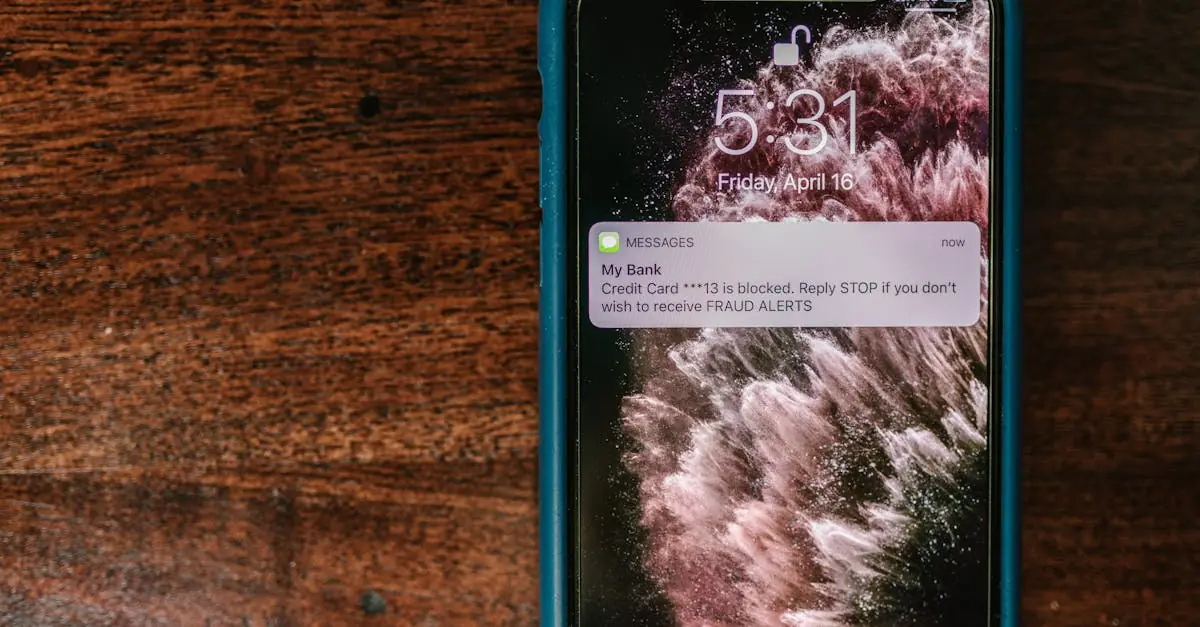Ever found yourself in the awkward situation of being blocked on iPhone? It’s like being stuck outside a party while everyone else is inside having a blast. But don’t worry—there’s still hope! Whether it’s a misunderstanding or a dramatic fallout, there are clever ways to send that all-important message without resorting to carrier pigeons or smoke signals.
Table of Contents
ToggleUnderstanding Blocking on iPhone
Blocking on an iPhone creates a barrier that prevents communication with the blocked individual. Users often face challenges when this occurs but understanding its mechanics helps navigate the situation.
What Does Blocking Mean?
Blocking means stopping someone from contacting a user through calls, texts, or other communication methods. When someone is blocked, their messages and calls go straight to voicemail or become undelivered. This action protects users from unwanted interactions. Social interactions change significantly when someone faces this restriction, leading to feelings of exclusion. Understanding the implications of blocking offers insight into the dynamics of digital communication.
How Blocking Works on iPhone
Blocking on an iPhone involves simple steps within the settings menu. Users can access the Phone or Messages app to find the specific contact settings. During this process, if a number is blocked, it cannot leave any messages on the device. Calls won’t ring through, and notifications won’t appear, maintaining the user’s peace. The process ensures that the blocked individual’s attempts to communicate remain invisible. Regardless of the reason for blocking, knowing its functionality provides a clearer perspective on related communication challenges.
Methods to Send a Message When Blocked
Reaching out despite being blocked on an iPhone requires some creativity. Here are a few methods to communicate effectively.
Using Alternative Messaging Apps
Alternative messaging apps offer seamless communication without the constraints of traditional messaging. Apps like WhatsApp, Signal, and Telegram allow users to send messages over the internet. These platforms bypass SMS restrictions imposed by block features on iPhones. When the blocked individual uses such an app, they can initiate conversations without interference. Shared accounts or phone numbers can facilitate contact, making interactions possible.
Sending Emails as an Alternative
Emails serve as an effective replacement for standard messaging when blocked. Users can reach out through email services like Gmail, Outlook, or Yahoo. By composing a message that conveys their thoughts clearly, individuals maintain lines of communication. Email does not rely on phone numbers, allowing messages to bypass blocking limitations. A well-crafted email may express the sender’s feelings or requests, offering a more formal alternative to texting.
Creating a New Contact
Creating a new contact can provide an innovative way to communicate. Users can assign a different name or number to the blocked individual, avoiding detection. When sending a message from a new contact, traditional blocking methods may not apply. A careful approach ensures messages appear as though they’re coming from a different source, allowing conversations to continue. This method can extend dialogue opportunities without needing to address the existing block directly.
Considerations and Ethical Implications
Communicating after being blocked carries significant ethical considerations. Understanding individual boundaries is crucial to maintain respectful interactions.
Respecting Privacy
Respecting privacy matters in all forms of communication. Blocked individuals express a desire for distance; therefore, attempting to connect through unauthorized means could exacerbate discomfort. Always consider the intent behind the block, noting that it reflects personal boundaries. It’s essential to prioritize the feelings of the other party. Navigating these scenarios requires care and sensitivity as disregarding someone’s privacy may lead to further conflict.
Importance of Communication
Effective communication plays an essential role in relationships. Inevitably, circumstances arise where misunderstandings occur, and blocking becomes necessary. Open dialogue can address issues constructively, fostering mutual understanding and respect. Seeking alternative methods for outreach can enhance connection, as long as they align with the other person’s consent. Honoring the need for communication without infringing on privacy emphasizes the importance of interpersonal relationships, navigating potential barriers thoughtfully.
Troubleshooting Common Issues
Communication can encounter various issues, especially when using alternative methods to connect with someone who has blocked you.
Issues with Alternative Methods
Users might experience difficulties when attempting to reach out through different apps. For instance, if the recipient has also blocked the app, messages won’t deliver. Some apps might require the recipient to install the service, potentially limiting your options. Delays in notifications may lead to frustration, making timely communication challenging. Additionally, privacy settings in these applications can restrict incoming messages, creating barriers even in supposedly open platforms. Understanding these limitations is crucial when seeking alternative methods.
When to Seek Help
Seeking assistance becomes necessary if communication attempts fail repeatedly. Online support communities may offer valuable insights and solutions. At times, consulting a professional can provide clarity on navigating difficult situations involving blocked communications. If interactions impact mental health, involving a counselor or therapist can help process feelings of rejection or frustration. Prioritizing emotional well-being is essential, particularly when dealing with the complexities of blocked communication. Recognizing when to ask for help ensures you maintain a balanced perspective and focus on healthy relationship dynamics.
Navigating the complexities of blocked communication on an iPhone can be challenging. While it’s important to respect the boundaries set by others, there are ways to express thoughts and feelings without crossing ethical lines. Using alternative messaging apps or email can provide avenues to reconnect while maintaining respect for privacy.
However, if attempts to communicate don’t yield results, it might be time to reflect on the relationship dynamics. Prioritizing emotional well-being is crucial in these situations. Ultimately, fostering open and honest dialogue can pave the way for understanding and healing, ensuring that both parties feel heard and valued.



